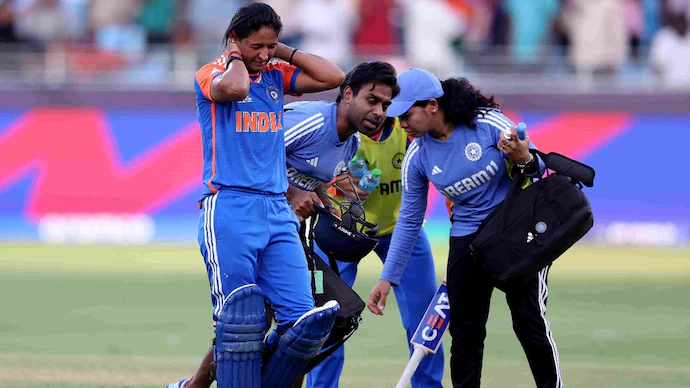Cricket fans frequently hear the term “Retired Hurt,” especially when a player exits the field due to injury. But what exactly does Retired Hurt mean in cricket, and why does it happen? In this blog, we’ll break down the meaning of Retired Hurt, the reasons behind it, and the significant impact this decision can have on both the player and the team.
Understanding the Term Retired Hurt in Cricket
When a player leaves the field due to an injury, they’re often marked as “Retired Hurt.” This is not just a technical term; it reflects moments of physical struggle and sometimes deep emotional strain for players. Retiring hurt means stepping away temporarily, with the possibility of returning if the player recovers.
Retired Hurt Meaning
In simple terms, Retired Hurt means a player exits the field because of an injury or physical issue that prevents them from continuing. This decision is usually made to protect the player’s health, allowing them time to recover with the option of returning later if they’re fit to play.
Key Points of Retired Hurt
- Temporary Exit: Unlike being dismissed, Retired Hurt allows the player to return if they recover during the match.
- Health Priority: This rule ensures that players don’t push beyond their physical limits, which could lead to long-term injuries.
- Impact on Game Strategy: When a player retires hurt, it affects the team’s plans and requires quick adjustments.
Why Does Retired Hurt Happen?
Retired Hurt happens for various reasons, primarily injuries or sudden physical discomfort. Here are some of the most common reasons why players choose (or are advised) to retire hurt:
1. Physical Injury During Play
The most common reason for Retired Hurt in cricket is a direct injury, such as getting hit by a ball, spraining an ankle, or suffering a muscle pull. Since cricket involves high-speed balls, swift movements, and intense concentration, injuries are relatively common.
- Example: A player batting at the crease may get struck by a fast ball, causing bruising or even fractures. If the injury is severe, they may retire hurt and seek medical attention.
2. Severe Cramping or Muscle Strain
Long hours on the field and intense physical exertion can lead to muscle cramps or strain, especially during test matches. Players may retire hurt temporarily to manage their discomfort and prevent the cramping from worsening.
- Example: Cricketers, particularly in longer formats, often experience leg cramps. This can make it difficult to run between wickets, and retiring hurt might be the best option.
3. Fatigue and Dehydration
Especially in extreme weather conditions, players can experience severe fatigue or dehydration. When the physical toll becomes too high, players may retire hurt to avoid serious health risks. This is often the case in day-long test matches under scorching heat.
4. Serious Injuries Impacting Career
In rare cases, players retire hurt due to severe injuries that could potentially end their careers if not managed carefully. Knee injuries, back pain, or even concussions from fast balls are taken very seriously. Sometimes, players don’t return after such injuries to prevent long-term damage.
- Example: When a player suffers a serious injury, their immediate reaction might be to leave the field, but their decision to return depends on medical advice.
The Impact of Retired Hurt on the Team
Retiring hurt doesn’t only impact the player; it also affects the entire team. Here’s how:
1. Changing the Batting Order
When a batsman retires hurt, it disrupts the batting lineup. Coaches and captains must adjust the order, sometimes sending less-experienced players earlier or asking others to play in different styles. This change can throw off the team’s strategy and make the game more challenging.
2. Pressure on Other Players
With a key player off the field, remaining players face additional pressure. In cases where top-order batsmen retire hurt, middle and lower-order players are often forced to take on more responsibility, which can be a challenging shift in high-stakes matches.
3. Psychological Impact on the Team
Watching a teammate retire hurt can be emotionally tough for players. Cricket is a team game, and seeing a key member leave due to injury often adds stress and worry. This can impact team morale and, ultimately, their performance.
Notable Retired Hurt Moments in Cricket History
Retired Hurt incidents have been memorable moments in cricket’s history, some of which stand out for their intensity and impact. Here are a few notable instances:
Allan Border’s 1987 World Cup Incident
Allan Border, the legendary Australian captain, suffered an injury during a crucial 1987 World Cup match against India. His decision to retire hurt affected Australia’s game plan and showcased the delicate balance between pushing through and protecting one’s health.
Brian Lara’s Heart-Wrenching Moment in 2001
In 2001, West Indies’ star batsman Brian Lara retired hurt during a test match due to a serious back injury. Fans were devastated, and Lara’s absence impacted the game’s outcome, leaving fans wondering what could have been.
Sachin Tendulkar’s Painful Exit
In 2004, Sachin Tendulkar retired hurt during a test match after being struck on his elbow. This incident was memorable as fans watched one of cricket’s greatest players leave the field in pain, a rare sight that had fans around the world concerned.
Statistics on Retired Hurt Incidents
To understand the impact of Retired Hurt in cricket, let’s look at some statistics that highlight its significance:
- Frequency: Around 10-15% of professional cricket injuries lead to players retiring hurt during the match.
- Return Rate: Approximately 35-40% of players who retire hurt manage to return in the same game.
- Missed Games: Players who retire hurt often miss around 2-3 subsequent matches, depending on the injury’s severity.
How Technology Helps Manage Injuries Today
Advancements in sports science and technology have improved how injuries are managed in cricket. Teams now use wearable devices to monitor players’ physical stats, helping coaches identify potential health issues before they escalate.
Modern Practices for Injury Management
- Fitness Tracking: Devices track heart rate, hydration levels, and physical exertion, allowing coaches to prevent fatigue-related retirements.
- Advanced Rehab Facilities: Teams now have access to state-of-the-art facilities to help players recover faster.
Why Retired Hurt Moments Are Memorable in Cricket
Cricket is more than just a game of bat and ball; it’s about human resilience, sacrifice, and passion. Retired Hurt incidents remind us of the physical toll cricket takes on players and how they push through for their team. Moments like Brian Lara or Sachin Tendulkar retiring hurt have become part of cricket lore because they reflect the delicate balance between a player’s drive and their physical limitations.
Watching a player retire hurt often creates a ripple of emotions among fans and players alike. It adds to the drama of the game, reminding us of the courage and vulnerability that make cricket such a beloved sport.
Conclusion
Retired Hurt incidents in cricket are more than just medical matters; they are stories of struggle, perseverance, and, sometimes, heartbreak. The meaning of Retired Hurt goes beyond the dictionary—it represents moments when players confront their physical limits, sometimes choosing to fight through pain for the love of the game. Understanding these moments allows fans to appreciate the sport even more, recognizing the strength, dedication, and resilience each player brings to the field.
FAQs About Retired Hurt in Cricket
What does Retired Hurt mean in cricket?
Retired Hurt means a player leaves the field due to an injury or physical issue but can return if they recover during the match.
Why do players retire hurt in cricket?
Players retire hurt for reasons such as injuries, muscle cramps, fatigue, or to prevent serious long-term damage.
Can a player return after retiring hurt?
Yes, a player can return if they recover from the injury or physical issue that led them to retire hurt initially.
How often does Retired Hurt happen in cricket?
Retired Hurt incidents are relatively rare but are most common in intense games where injuries or physical strain are high.
Will Retired Hurt affect a player’s career?
It depends on the injury’s severity. While many players recover quickly, serious injuries leading to Retired Hurt can impact a player’s career in the long term.
















